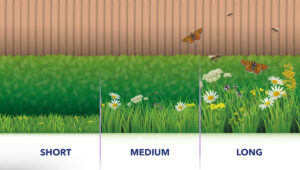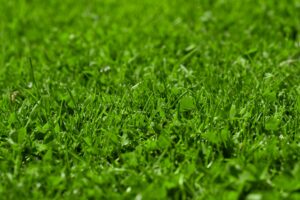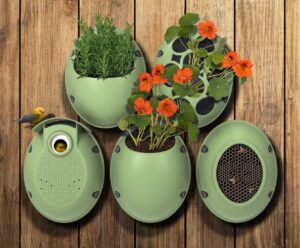With dehydrating summer droughts and hosepipe bans in effect around the country, whilst intermittent torrential rain makes for soggy conditions elsewhere, keeping your lawn in tip-top condition has not been easy this year. As we head towards autumn, a prime time for lawn repair and recovery, Johnsons Lawn Seed is here to calm the storm and make lawncare a breeze!
End of Summer blues
After a season of typically unpredictable British weather, outdoor entertaining, school holidays and pet performances, the average lawn is bound to be looking rather worse for wear, sporting worn out, scrubby grass, compacted soil and unsightly brown patches. Whilst too much sun will leave your lawn parched, brown and dead-looking, too much rain can result in waterlogging, moss growth and fungal infections.
Autumn is the time to make good on the damage and prepare your lawn for its dormant period during the winter months. The time you put in now will be rewarded with a newly rejuvenated, luscious green lawn ready to welcome you in spring.
September is the ideal time to give your lawn some care and attention, well before the frost sets in. The earlier you can start in autumn, the better the results will be next year. Guy Jenkins, consumer manager at Johnsons Lawn Seed, recommends you take the following steps to repair your lawn:
Aeration
Heavy usage over summer invariably results in compacted soil, which prevents oxygen, water and nutrients from reaching the roots of your lawn grass. This leads to a decidedly jaded appearance that will struggle to recover without some help. The problem is easily solved via aeration, which entails punching small holes through the grass and into the soil to create some breathing space. You can accomplish this task easily with a garden fork, although bear in mind that a hollow-tine aerator is more effective, especially for heavy clay soils and severely compacted grass.
After aerating, you should apply a top dressing to fill the holes and improve soil structure. The ideal top-dressing for this task consists of three parts sandy loam, six parts sharp sand and one part leaf mulch or other compost.
Levelling
Next, you want to level out your lawn, removing any bumps or hollows that allow water to pool. Areas of heavy usage are especially prone to being hollowed out and September is the perfect time to start smoothing over the surface of your lawn so that it’s able to withstand frost and snow come the winter.
To accomplish the task, use a spade to gently lift and roll back turf to uncover the underlying soil in uneven areas, then adjust the level by adding or removing soil as necessary, until you’ve achieved a smooth, flat surface. You can then roll the turf back into position, pressing down the cut edges to ensure that it’s firmly secured. Water thoroughly to help re-establish root growth and give your lawn the best possible start next spring season.
Scarifying
Just as weeds are liable to take over garden beds and borders if you don’t keep on top of them, a build-up of thatch – dead grass, moss and weeds – can overlay your lawn, especially if there’s been a lot of rain. This has the same deadening effect as compacted soil, preventing air and water from reaching grassroots, as the thatch hogs nutrients and starves your grass.
Start this process with a rake to remove surface-level thatch, then switch to a scarifier tool for deeper-rooted material. Just take care not to go too deep when raking or scarifying, as you might damage the underlying turf.
Seeding
If all this activity has left your lawn looking patchy, with grass that’s thin on the ground, overseeding with new grass seed over your existing lawn is the solution. Overseeding in autumn allows the new grass to develop strong roots before winter, which will support fabulous green growth in spring. Johnsons Lawn Seed supplies a comprehensive range of grass seed to suit different conditions.
Quick Lawn with Accelerator: The best all-round mix that money can buy, Quick Lawn combines a beautiful fine-leaved appearance with robust properties that can survive wear and tear and is tolerant to both shade and drought. The child and pet-friendly Accelerator attracts beneficial bacteria found in soil to the grass roots to aid their establishment.
Shady Place with SeedBooster®: Ideal for areas with limited sunlight, offering good drought tolerance, Shady Place with SeedBooster®* does what it says on the tin whilst offering a harmless deterrent to birds.
Tuffgrass: This is a great option for pet parents whose lawns need to endure more than just rain, wind, sun, snow and frost. This popular lawn seed blend is developed to withstand both heavy foot traffic and resistance to yellow patches caused by dog urine.
Luxury Lawn with Seedbooster®: As the name suggests, Luxury Lawn is a premium grass seed blend that delivers a dense, fine-texture, lush-green lawn, perfect for snoozing on warm spring-summer days, designed to draw envious glances from neighbours on either side!
Lawn seed should be evenly distributed across the area to be reseeded, focusing on patchy areas. After scattering, gently press the seed into the soil so it won’t easily blow away. Maintain consistent moisture levels with light watering until the new grass is established.
Mowing
Grass growth will slow down as outdoor temperatures sink, but you should still mow your lawn regularly in preparation for winter. Avoid cutting grass too short and gradually increase your mower’s cutting height to protect grass from frost and cold weather. Ensure mower blades are kept sharp to prevent damage to the grass. The golden rule for mowing is to never to cut more than a third of the grass blade’s length at a time.
To find out more about Johnsons Lawn Seed products please visit http://www.johnsonslawnseed.com/product-range.aspx
* Seedbooster® is an innovative two-in-one seed coating developed for the professional turf market.


















